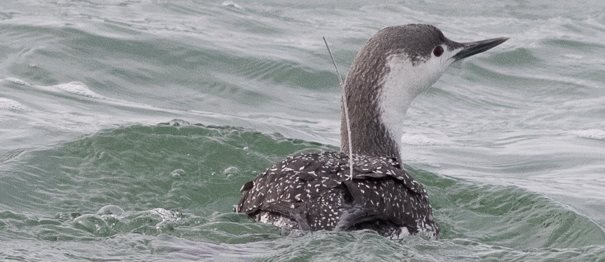← Back
Red-throated divers move away from offshore wind farms

Argos can help in evaluating overlaps of human activities and protected aquatic bird habitats. With that information, the planning of new infrastructures such as offshore wind farms can take species like the red-throated divers in consideration.
Wind farms on protected aquatic bird habitats
The red-throated diver (Gavia Stellata) is a strictly protected aquatic bird, particularly sensitive to anthropogenic disturbances. When not breeding (in boreal and Arctic lakes), Red-throated divers are found in the relatively shallow coastal waters of the Northern hemisphere. Their preferred habitats are overlapping with human activities and infrastructures, including offshore wind farms. The German Bight (eastern North Sea) is among the places where construction of wind farms is expanding, and it is therefore important to estimate their impacts on the birds’ behaviour and population.
A study uses Argos satellite telemetry locations of red-throated divers and aerial video surveys, in a distribution modelling approach taking environmental data into account, similar to the one mentioned in Distribution of baleen whales in the mid-North Atlantic Ocean with pseudo-absence generated, but no prey model as input.
More info about birds tracking
Very few red-throated divers within the wind farm areas
In this project, forty-five red-throated divers were tagged in the German Bight in the winters of 2015, 2016 and 2017, in an area where six wind farms have been built.
Direct analysis of Argos telemetry shows very few locations within the wind farms’ areas (9 on 2682), and of the aerial video survey none, and very few within 5 km, even though the areas show high habitat suitability in a modelled scenario without the wind farms. The telemetry data also indicate that the displacement distance decreases with decreasing visibility. Both approaches find that red-throated divers are strongly displaced in suitable habitat from wind farms and 5 km around with their density 90 % lower than the reference. The effect decreases with distance from wind farms, however, a significant reduction could be found up to 15 km away.
Considering red-throated divers in wind farm planning
It must be noticed that the study does not consider population impacts, only displacements. The study therefore does not reveal how the displacements affects the total size of the population. However, these results should be taken into consideration in spatial planning of offshore wind farms to avoid impacts on red-throated divers.
References
- Stefan Heinänen, Ramūnas Žydelis, Birgit Kleinschmidt, Monika Dorsch, Claudia Burger, Julius Morkūnas, Petra Quillfeldt, Georg Nehls, 2020: Satellite telemetry and digital aerial surveys show strong displacement of red-throated divers (Gavia stellata) from offshore wind farms”, Marine Environmental Research, https://doi.org/10.1016/j.marenvres.2020.104989
- divertracking.com
Photo: A red-throated diver with an Argos Tag (Credit Claudia Burger)

